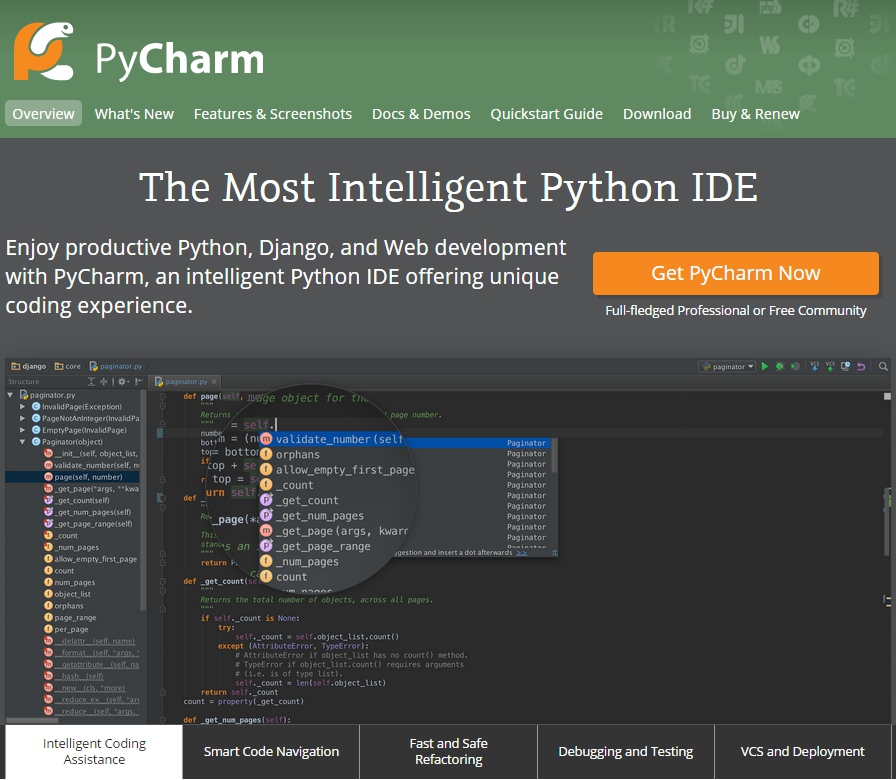PyCharm¶
PyCharm is an excellent IDE for the Python language.

Overview¶
Python being a dynamic language, using an IDE is a really good idea. This will help you find errors at development time rather that at runtime. There are various IDE for pythons around (see python IDE comparison).
If you are going to write non trival python programs for some time, then we recommend using PyCharm. It will save you time. PyCharm is usually faster, simpler and more powerful than PyDev, the python environment on eclipse. If you are really a huge fan of eclipse, you might prefer PyDev indeed.
Installation¶
There are two versions:
- An open source version which is quite complete and very useful.
- A commercial version which has support for django, databases, etc.
Attention
If you are student you can very easily get PyCharm for students. You just need to register with the email of your university. It’s really easy and quite fast.
download PyCharm page and then download the appropriate version (e.g. Windows community edition (web), Windows commercial edition (web)).
install the version downloaded in a directory like
%SCRIBESTOOLS%\PyCharmOpenor%SCRIBESTOOLS%\PyCharmCommercial. This naming schema allows to have both editions installed at the same time.by default your personal configuration of PyCharm goes in a directory like
.PyCharmin your home directory, but if you want you can change this by editing the filebin/idea.propertiesin the installation directory. You have to adjust for instance the following two lines:idea.config.path=Z:/.PyCharm50/config idea.system.path=Z:/.PyCharm50/system
Launching PyCharm¶
The installer most likely created a shortcut. Click on it to launch PyCharm.
Alternatively you can also find the executable in the bin directory of the
installation or in a standard bin directory (e.g. /usr/bin/pycharm).
Launching PyCharm the first time¶
When launching pycharm for the first time, you will have no .PyCharm50
in your home directory. This directory contains the global configuration
describing your global preference, your environment, the licencing information,
and so on. PyCharm will therefore ask a few questions.
If you use the commercial version of PyCharm, you have to provide information for:
- your pycharm/jetbrain account (created before) if you work at home for instance,
- or a pycharm server licence if you work at university for instance. If you
are in the context of the UGA enter
http://im2ag-licence.e-im2ag.ujf-grenoble.fr:1111for the licence server.
Opening/Creating PyCharm projects¶
Just like eclipse or netbeans, PyCharm is NOT a text file editor. So one do not
open a file when launching PyCharm, but on the contrary create a project
at a given place; and this project (or other projects) will always be opened and
used in next sessions. A PyCharm project is simply a directory with a .idea
subdirectory. This .idea subdirectoy is created on the first time and then
managed by PyCharm.
When launching PyCharm you have to select your “project” directory,
that is the directory that contains all files you want to work on.
Usually this is the directory that also contains versioning information, so
it is most likely that this project directory will contain both .idea and
.git subdirectories (if you are using Git).
Note
The normal way to proceed with PyCharm is to open only projects and
you should therefore have only one .idea directory at the top level
of your “project directory”.
Documentation¶
Documentation is available from the help menu of the tool.